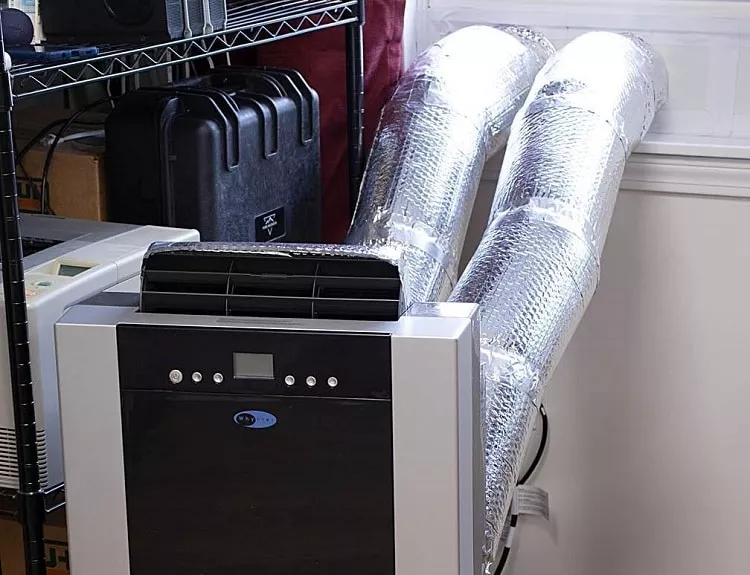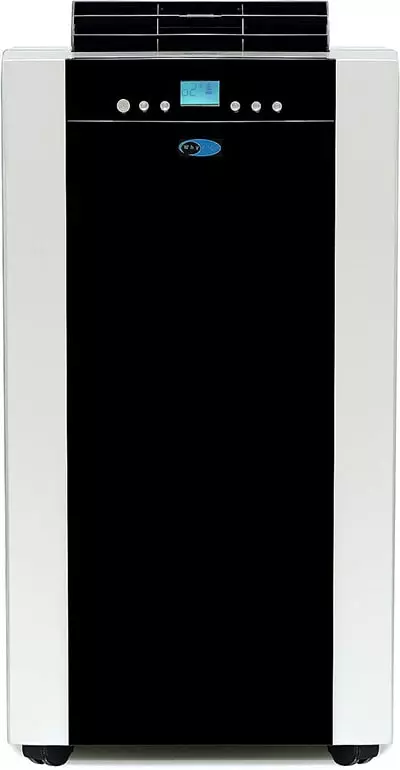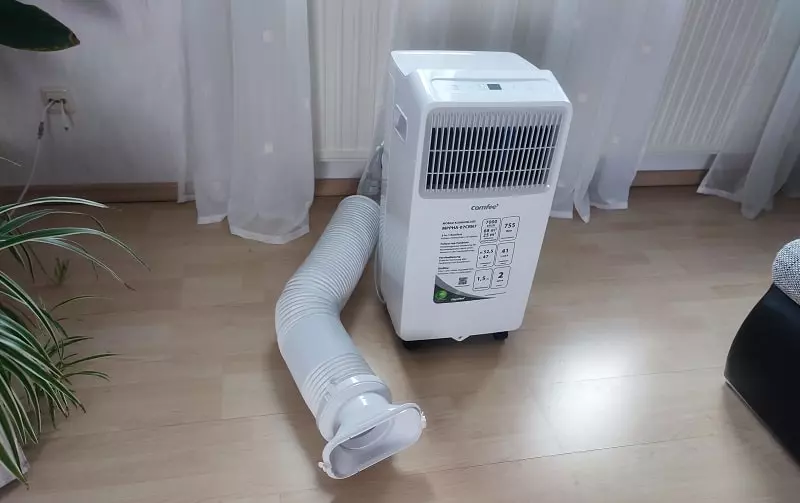Many people are confused about which type of portable air conditioner to buy. If you are also questioning whether to buy a single-hose or dual-hose AC, here’s your answer:
Dual-hose portable air conditioners are more efficient than single-hose as they don’t suck any outdoor air into the room due to negative pressure. A dual-hose unit is perfect for larger spaces because it can cool an area more quickly and efficiently than a single-hose AC.
However, numerous other factors differentiate single-hose and dual-hose ACs, including price, features, portability, compatibility with other appliances, and ease of use.
In this article, I’ll explain what single-hose and dual-hose portable air conditioners are. I will also compare the two types of ACs and give you my verdict on which is better.
Read on to find out!
Comparison: Single vs Dual Hose Portable Air Conditioners
| Factor | Single-Hose Portable Unit | Dual-Hose Portable Unit |
|---|---|---|
| Price | Affordable | Slightly more expensive |
| Cooling Efficiency | Bad | Good |
| Maintenance | Easy | Easy |
| Installation | Simple | Simple |
| Recommended Product | BLACK+DECKER single-hose AC (click to view it on amazon) | Whynter dual-hose AC (click to view it on amazon) |
This table shows the differences between single-hose and dual-hose portable air conditioners.
The two main types of portable air conditioners are single-hose and dual-hose units. Both have their pros and cons, so it’s important to choose the right one for your needs.
If you’re looking for an efficient way to cool your room, garage, or office, then a dual hose unit may be just what you need. They offer superior performance as compared to single-hose air conditioners.
Single-hose portable air conditioners are less expensive, but they are less effective. Dual hose units cost more, but they cool more effectively and can also help to reduce humidity levels in a room.
 Probably the most popular dual-hose portable AC: The Whynter ARC-14S
Probably the most popular dual-hose portable AC: The Whynter ARC-14S
Single-Hose Portable Air Conditioners
Single-hose portable air conditioners have one exhaust hose to expel warm air out of the room. They are the most common type of portable air conditioner because of their easy installation and affordability.
How Do Single-Hose Portable Air Conditioners Work?
Single-hose portable air conditioners use a single vent to remove the hot and humid air from the room. The hose runs from the AC unit to the window, door, or wall hole.
Single-hose portable air conditioners absorb the heat from your room, exhaust the absorbed heat and blow out cooled air.
However, nothing prevents your single-hose portable AC from sucking in the just-cooled air again and blowing it out of the window.
This is a major efficiency problem in single-hose portable air conditioner functionality.
Also, since the AC unit continuously removes the hot air from the room, the air pressure inside the room drops lower than the atmospheric pressure outside, which results in a negative pressure gradient.
As a result, the hot outside air has to move inside the room to balance that negative pressure gradient. However, it’s not pulled directly through the unit. Instead, it sneaks in through the cracks and crevices.
Even if all the windows, vents, and doors are closed, hot air will find its way to come in through very small crevices, floor clearance, and window gaps.
This hot air will again increase the room’s temperature, which causes a decrease in efficiency and causes the AC to have a higher average power consumption.
Overall, this single-hose working cycle keeps the unit constantly under pressure. It decreases the unit’s efficiency and will add up more energy costs.
Advantages of Single-Hose Portable Air Conditioners
#1 Lower Initial Cost
Single-hose portable air conditioners typically have a lower initial cost compared to dual-hose models. The simplified design, which utilizes just one hose for venting hot air, contributes to a reduced cost for parts and materials. Prices can range from around $100 to $400, depending on factors like cooling capacity and overall build quality.
#2 Simplified Installation
In spaces devoid of windows or vents, single-hose units offer a more straightforward installation process. Only one hole needs to be created in the wall to accommodate the hose, thereby minimizing both installation time and potential structural modifications. This can translate into lower installation costs compared to dual-hose units, which would require two holes.
#3 Easier Maintenance
Maintaining a single-hose air conditioner tends to be simpler than its dual-hose counterpart. For example, air filters in single-hose units are often easily accessible from the exterior, facilitating quick and convenient cleaning or replacement. This ease of maintenance can contribute to a longer lifespan for the unit if proper upkeep is observed.
 Single-hose portable air conditioners are easy to install - but they are less efficient.
Single-hose portable air conditioners are easy to install - but they are less efficient.
Disadvantages of Single-Hose Portable Air Conditioners
#1 Lower Cooling Efficiency
Single-hose air conditioners tend to have a lower cooling efficiency compared to their dual-hose counterparts. This is often reflected in their average BTU (British Thermal Unit) ratings, which are typically lower. As a result, these units may take longer to cool a room and may consume more energy in the process.
#2 Limited Area Coverage
Single-hose units are generally less effective for cooling larger spaces. They are best suited for smaller rooms where the heat load is not excessively high. Using a single-hose unit in a large room may result in inadequate cooling and higher energy consumption.
#3 Negative Air Pressure Issues
One of the downsides of using a single-hose unit is that it creates negative air pressure in the room. This can lead to several problems, including pulling in warm, humid air from other parts of the building or from outside. The negative pressure can also exacerbate issues related to moisture and mold build-up within the room.
#4 Risk of Drawing in Outdoor Pollutants
Single-hose units can be particularly problematic if the outdoor air quality is poor. Due to the negative air pressure they create, harmful pollutants like smoke can be drawn into the room. Contrary to what one might expect, typical air filters in these units are not designed to handle such pollutants because the infiltrating air often enters through gaps and crevices in the room, bypassing the unit’s filtration system.
Best Single-Hose Portable Air Conditioner
Ideally, your single-hose portable air conditioner should have the following features:
- Remote control: Allows you to easily switch between cooling and conditioning modes without walking across the room.
- Energy Saving Mode: lowers your AC’s power consumption when it is not being used so that it uses less energy overall. This can help you save money on your electricity bill.
- Timer Function: Allows you to set a predetermined time for the AC to turn off automatically. This is useful if you want the room to be cool before bedtime or in case of some unexpected event that causes extended use beyond your normal limit.
My Recommendation: This BLACK+DECKER Air Conditioner (14,000 BTU) (click here to view it on amazon)
Black & Decker is known for its durable yet sleek products that are efficient in every way possible.
With such a high number of reviews on Amazon, we can’t help but say that this AC is great.
With a weight of 62.4 pounds, this portable air conditioner has a 14000 BTU cooling capacity, ensuring that you get a comfortable temperature quickly. Its freeze-proof compressor ensures that it works even in the most extreme conditions.
The unit comes with an easy-to-use remote control so that you don’t have to fumble around with buttons or try to figure out where they are while keeping your hands free.
This air conditioner comes with a 24 hours timer feature which helps regulate the temperature according to your requirement, ensuring maximum comfort and convenience every time you use it! So what are you waiting for?
Dual-Hose Portable Air Conditioners
Dual-hose portable air conditioners have two separate hoses: one for intake and one for exhaust. This design helps the unit to cool more effectively than a single-hose unit because it allows the air conditioner to take in cooler air from outside while expelling the warm air from the room.
These units are ideal for larger spaces because they can cool an area faster than a regular air conditioning unit. Dual hose units also have better airflow control, which means they can distribute the cooling evenly throughout the room.
How Do Dual-Hose Portable Air Conditioners Work?
Compared to single-hose, dual-hose portable air conditioners have an extra hose that allows them to suck in outside air and cool it instead of cooling indoor air and blowing it outdoors.
The intake hose will pull the air from the outside through the window or the door. The pulled air will run through the condenser, where heat is absorbed.
The cooled air is blown into the room, while the extracted heat is blown outside again.
Once it passes through, the second hose will expel it back into the environment.
This process doesn’t create a negative pressure gradient like single-hose air conditioners. This way, the unit won’t bring warm outside air into the room.
Advantages of Dual-Hose Portable Air Conditioners
#1 Faster Cooling Time
Dual-hose air conditioning units offer more efficient cooling by having superior airflow control compared to their single-hose counterparts. This allows the cooled air to circulate more quickly and evenly throughout the room, resulting in a more rapid drop in temperature.
#2 Versatility in Placement
Contrary to the notion that dual-hose units require more space, the space requirement is generally comparable to single-hose models. This means dual-hose air conditioners can be effectively utilized in tight or confined spaces without sacrificing performance.
#3 Elimination of Negative Air Pressure
One major advantage of dual-hose air conditioners is that they prevent the creation of negative air pressure in the room. Unlike single-hose models, they do not pull in warm air from the outside, which helps maintain a balanced indoor environment. This is beneficial in mitigating issues like mildew and other humidity-related problems.
#4 Ease of Maintenance
Dual-hose air conditioning units usually come with easily accessible filters and coils that can be cleaned with just water. Regular maintenance not only extends the longevity of the unit but also ensures that the air quality in your home remains free from harmful pollutants and unpleasant odors.
Disadvantages of Dual-Hose Portable Air Conditioners
#1 Higher Initial Cost
While dual-hose air conditioners offer enhanced cooling performance, they come with a higher initial cost compared to single-hose units. The increased expense is primarily due to the additional components and materials required for the dual-hose configuration. Additionally, dual-hose models often come with higher cooling capacities, further contributing to their elevated price point.
#2 Increased Space Requirement for Hoses
Though the main unit’s size is comparable to single-hose models, dual-hose air conditioners do require slightly more room for hose placement. Since there are two hoses to consider, they take up more window space than a single hose. While the extra space requirement is generally minimal, it is something to consider if you have limited window area.
#3 Requirement for Dual Vent Openings
In cases where there are no existing vents or windows, you’ll need to create two openings in the wall to accommodate both hoses. This not only demands extra labor but could also involve structural considerations, potentially complicating the installation process.
Best Dual-Hose Portable Air Conditioner
This one is the single-best portable air conditioner. I always recommend dual-hose air conditioners. And the Whynter ARC-14S is the most efficient and most powerful of them all.
My Recommendation: This Whynter ARC-14S (14,000 BTU) portable air conditioner (click here to view it on amazon)
The Whynter ARC-14S is the best portable air conditioner for your large space requirement (up to 500 square feet). Then there are 3 fan speeds (high, medium, and low) that ensure cooling over a large area quickly and efficiently.
 The Whynter ARC-14S: Possibly the best portable air conditioner on the market.
The Whynter ARC-14S: Possibly the best portable air conditioner on the market.
This award-winning device features an extendable exhaust hose that allows you to easily adjust the airflow, giving you total control over your environment. And because Whynter’s industry-leading 1-year warranty backs it, you can feel confident that your investment is safe and protected.
Moreover, its multi-functional design makes it perfect for a variety of needs - from small spaces to large rooms.
It is portable and lightweight, making it perfect for those who need extra cooling in their space fast. The dehumidifying capacity of 71 pints per day means no moisture will harm your floor or furniture.
And thanks to its energy-efficient design, it’ll save you money while contributing to global clean energy solutions. So don’t miss out on this chance to relax in the comfort and style that Whynter is known for.
Conclusion
You should always prefer dual-hose portable air conditioners over single-hose portable air conditioners. Dual-hose air conditioners are a lot more efficient. Even though they cost more initially, their reduced running cost will pay for itself.
The choice between dual-hose and single-hose portable air conditioners ultimately depends on your specific needs, room size, and budget constraints.
Dual-hose units offer superior cooling efficiency, balanced indoor air pressure, and reduced risks of drawing in outdoor pollutants. While they come with a higher initial cost, the investment often pays off in the long run through more effective cooling and potentially lower energy bills.
On the other hand, single-hose units offer a lower upfront cost and simpler installation, particularly in spaces without existing vents or windows. However, they are generally less efficient and could result in higher energy costs over time, especially if used in larger spaces.
In terms of quality and durability, dual-hose units tend to have the edge, thanks to their more complex engineering and greater cooling capacities. However, this doesn’t make single-hose units an inferior choice across the board; they can be a suitable option for smaller rooms or for temporary use.
